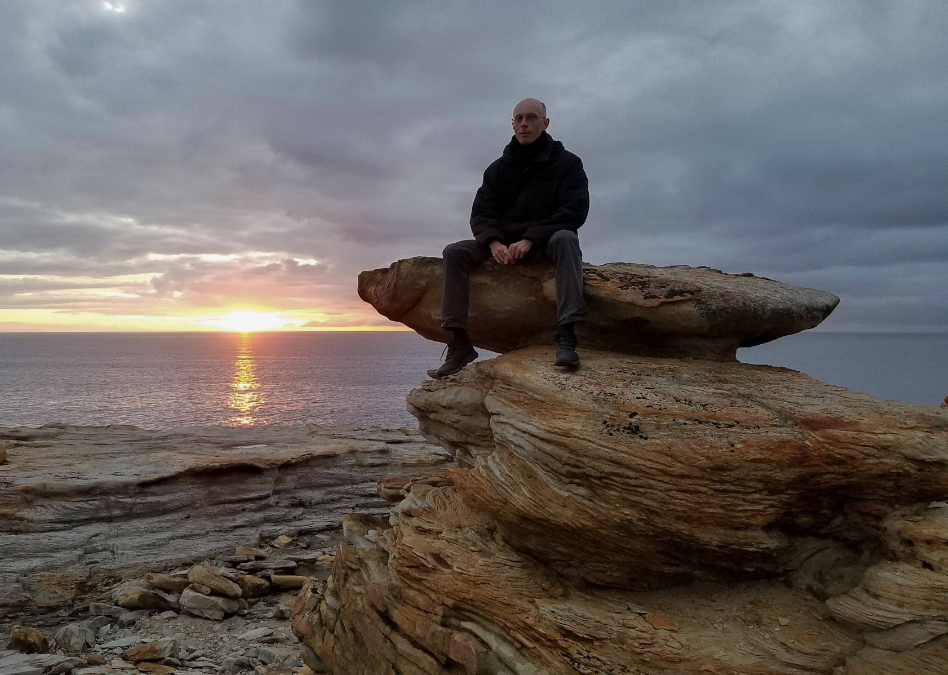
In the second part of the interview to the DataArt museum project, Pyotr Sobolev, also known as frog, the organizer of the ENLiGHT festival, recalls the history of the European demoscene and the first Russian demopati in a communal apartment converted into the office of the Shaping Federation.
Let's remind that in the first part we were talking about computers of the 1980s and getting to know the first intro and demo.
Piece of soul
I have never written a full demo in my life. Despite the fact that I am very fond of this and organized the festival. Virtually all the things I did were intros. The first was written in 1994–95. due to the fact that we organized in St. Petersburg ENLiGHT'95 - the first in Russia (and the countries of the former USSR) demopati. I will not say that that intro was anything - she took either the last or the penultimate place. But I actually didn't really try - I just wanted my work to be at the festival. There, in a cunning video mode, I imitated a battle between Pentium and 6502 processors. Like they fly at each other, as a result, 6502 stands with a spear over the Pentium, and the blood flows out.
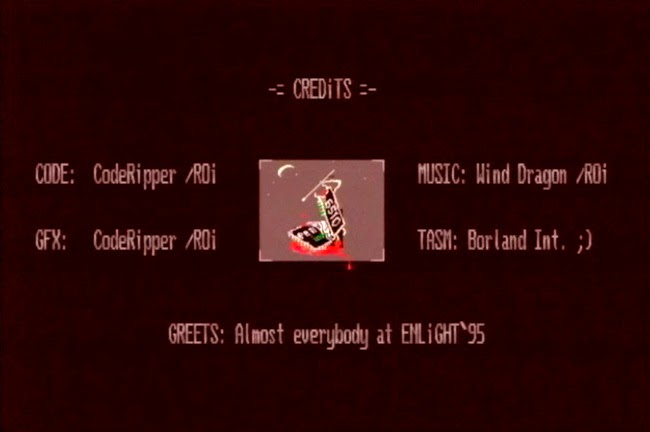
The credits of the same intro in which 6510 Victorious hits the Pentium
Then, later, I began to writesmall works for different old platforms . When it is 1 kilobyte in size, sometimes it is 256 bytes. It's just interesting to me. Now, when you are writing a program - no matter whether for yourself or for work - there are a lot of layers between you and the piece of hardware. A virtual machine, a bunch of drivers and packers, operating systems. Then you wrote the program directly for the hardware. I wrote the command and knew that it would be executed by the processor exactly as you wrote it. Write crookedly - it’s crooked and will work. If you write it right, it will work as it should, and it will be the same for everyone.
In addition, before, every processor, every architecture, every video controller, every computer had a certain personality. The same Commodore 64. Its people did not do it because the marketing department told them that a computer with such a processor and such software would be sold. They just decided: it would be right. They chose the 6502 processor because they could afford it for the money. We made this sound because the person who developed it started with synthesizers. He wanted the Commodore 64 to do the same thing - no one gave him orders. Each such platform had a piece of the developer's soul. I felt it very much.
Now, when you write for this platform, you are directly imbued: here a person thought that it should be like this, but here he could not, because he lacked the video controller registers, roughly speaking. A certain connection is being established with the people who, in the 70s, created this hardware and software.
Intro "No shaders" 256 bytes, created by Petr Sobolev for 1977 RCA Studio II game console. Took 4th place in the Tiny intro compo category at the CC'2018 festival
History of demopati
We saw the idea of the festival abroad. In the late 80s in Europe, including Eastern Europe, they began to organize something like a copy party. So we exchanged software, and they did the same, only they had a lot more people and software. At the same time - beer or something stronger. Gradually, ideas began to appear on such copy-and-paste: "Let's not just get together and copy something, but also show that we can, what we did ourselves." They began to bring and show their intro and demos. Over the course of a couple of years, this resulted in what is now called demopati. That is, people were already purposefully gathering in some hall, showing who brought what, who wrote what. Appreciated and admired.
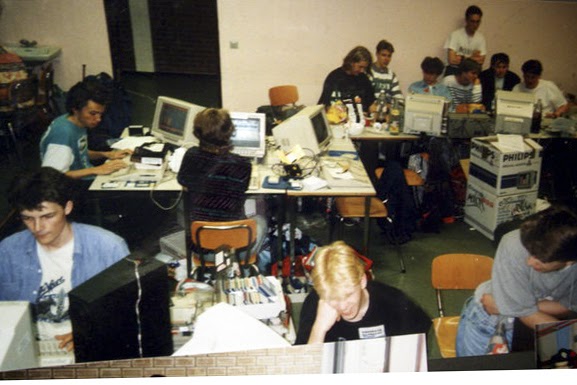
One of the European copypati. Late 1980s
The next step was the rules. Because it's stupid if demos are competing, one of which takes up a whole disk, and the other 1 KB. Incomparable. Therefore, we came up with and agreed upon separate categories, for example, 256 bytes, 1 KB, 4 KB, 64 KB. If you have a 64Kb limit, you have to be very perverted to cram a sufficiently impressive storyline and soundtrack into it. Especially if you have 4KB, or 1KB, or 256 bytes. It is clear that when a person writes a work of 256 bytes, he mainly thinks about the code, and not about the good music.
Then we made separate nominations for music and pictures. As a result, since 1992, quite official international demopaths have appeared, where there were completely clear rules, nominations for graphics, music, demo, intro.
Around 1991 or 1992, the first demopaths began to take place in Scandinavia. Why exactly there and not in America is a big question, to which no one has yet given a clear answer. Maybe this is due to the fact that people in the Nordic countries are not too worried about the future and can afford to do whatever they want. In the States, despite the fact that there were demopats there too and they are trying to conduct them now, the demoscene is presented in a very limited form. Although other, in many ways similar things - radio amateurs, for example - are very common there.
Impressive 256 byte demo from RSI team. Those who want to make sure of its originality can download the executable file in the description
Of course, we learned about the emergence of demopati. In the early 1990s, we already had PCs, the FidoNet network, modems appeared. All this reached us, we downloaded the work, watched it and also admired it. At some point, they wanted to do a similar event themselves. We started with the FidoNet echo conference called "DEMO.DESIGN" - a kind of offline forum. I arranged, roughly speaking, an open competition for correspondence there. At first it was a competition like "who can draw a triangle in a smaller code size." The condition is indicated: processor 286, VGA, for example. Then they made it more interesting. I had to write a small intro in some limited amount. The people liked it - they sent us works, including quite interesting ones. There was a Patson who, as I remember, sent in an impressive intro with fireworks - something beautiful was flying around there. Some of these peopleas in the West, they used to break software and retrain in the same way, one might say, legalized.
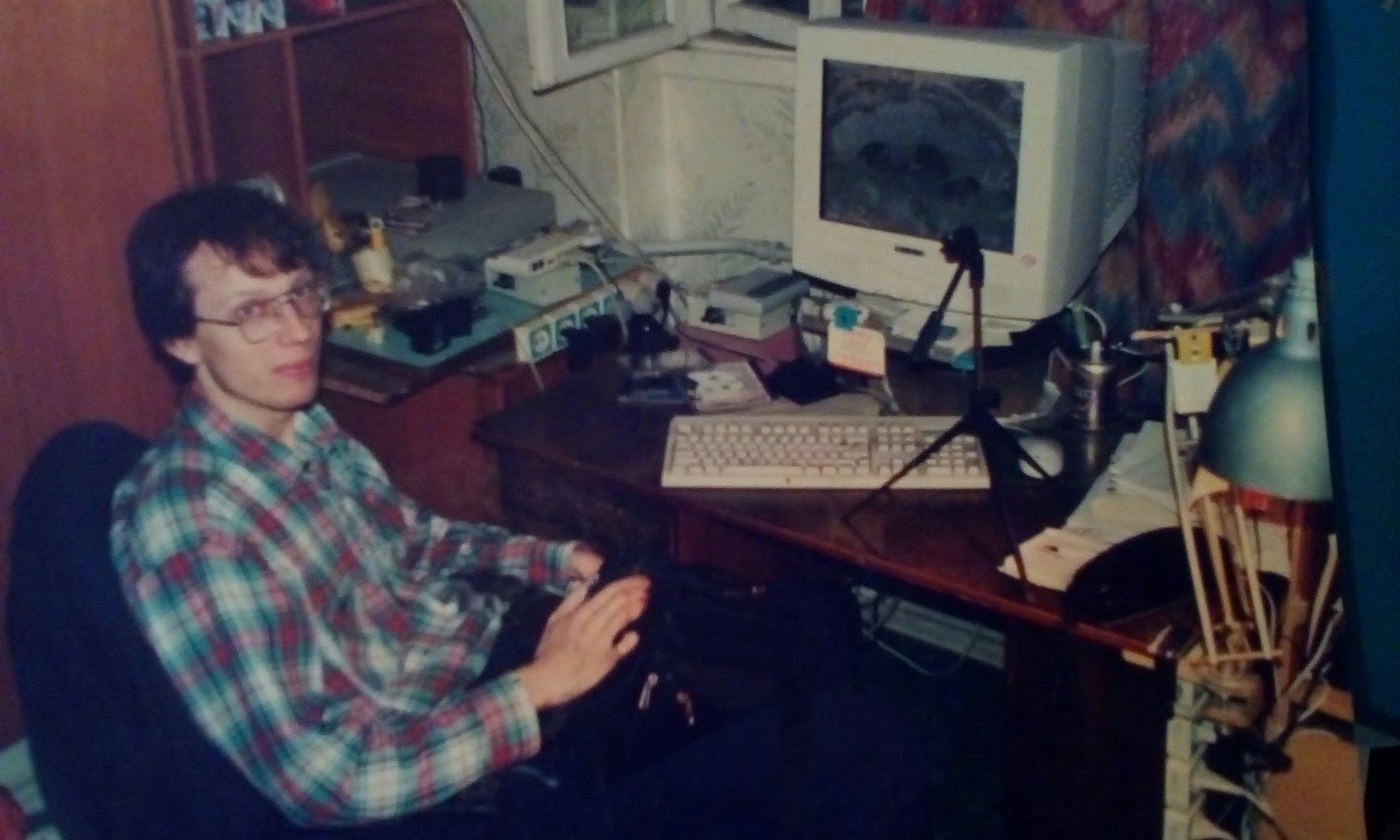
Pyotr Sobolev in the 1990s. On the left, above the sockets, you can see the USR Sportster modem (with an upgrade to HST)
My friends and I organized the Realm Of Illusion group , on whose behalf in 1994-1995. two issues of the electronic magazine "Infused Bytes" for PC were published. They were certainly made, both in terms of design and content - inspired by the ezines I've seen on the Commodore 64.
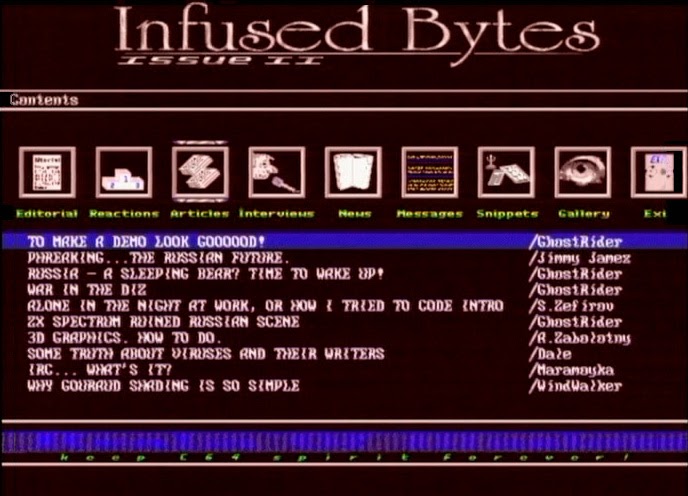
Diskmag Infused Bytes. Graduated from 1995
ENLiGHT'95
In 1994, we decided that we needed to hold an event like demopati. There was no money - then there were very big problems with the economy in the country, sponsors were not interested in advertising among some incomprehensible personalities. We were saved by the fact that in some companies there were people who just liked this topic. They persuaded their management to help: not with money, but with equipment and premises. One of the organizers, for example, worked as a system administrator in the Russian Shaping Federation and agreed that we would be given their office for the weekend. Another person borrowed two PC AT 486 computers with VGA from LANCK. They took a couple of TVs from someone so that more people could see the work - there were no video projectors then. Well, maybe there was one for the whole city.
As a result, in August 1995, we held the first demo party. It looked rather strange by today's standards. On Kazanskaya, in an old apartment building with a courtyard-well, there is an apartment converted into an office. Three rooms - one large, two smaller - and a corridor. Typical former communal apartment. We hung one TV in the room, the other was on the floor in the corridor. Somehow we connected them to PC, Commodore Amiga, Commodore 64. Strange as it may seem, there were entries for each nomination, albeit a little. People came and came from different cities - about 150 people, in this apartment there was no overcrowding.
In the corridor stood "Sonya" - a small control monitor from the television studio. In a large room hung a healthy Soviet television of the Photon-716 type. There were S-90 speakers and some kind of amp. As on any demo party, the announcement was made: "Competition works in such and such a nomination will be shown now." Then demos were shown on two TVs in a row. The audience memorized the works that they liked and voted on sheets of paper for the first, second and third places in each competition. I still have these leaves - since 1995 everything has been saved.

ENLiGHT'95. Footage from VHS cassettes
There was also a Real time coders compo competition. In two runs, they put people at the PC, gave them an hour of time and a task. It was necessary to write a code that beautifully converts one given picture in VGA format to another. The one who is more beautiful won, the size is not important. They wrote in Turbo Pascal, with assembler inserts. Participated Andrei Zabolotny, Mad Max and someone else. We wrote some pretty impressive things.
So those two August days passed. We launched an IRC client and wrote in the chat what was happening. The party went on continuously, contests took 10 percent of the time. It was almost the first time, perhaps, with the exception of sysops at Komtek, when there were people who were not just interested in IT, but specifically write code or at least regularly watch demos. And from all over the Union - from Belarus, Moldova, Ukraine, Moscow, Voronezh ... They all talked. There were guys who broke software - this is close enough to the demoscene. Fidoshniki were, of course. Preserved footage on VHS, in which you can see people who later became famous.
Understandably, beer. I remember we went out into the well yard. People were having fun throwing three-inch discs. The neighbors did not like it, but it did not last long, and the police did not come that time.
. 1995
ENLiGHT’96
The next year we decided to repeat the demopati. There was no more money, but we managed to knock out the room more spacious - in the Shipbuilding Institute on Leninsky Prospekt, where there was an admissions committee. We hung several TVs in the hall, put several computers, there were more contests, the Internet became more decent ... Spectrum appeared, it was already becoming the main computer of the domestic demoscene, a lot of people started writing for it. In the 95th "Spectrum" in the competitions was not yet present, spektrumisty only looked closely at what kind of beast - demopati. But in 1996 - in full. And they had their own organizer - Volodya Larkov - and a lot of work.
Sometimes I watch the video filmed then - it seems that literally everyone who was at least somehow interested in IT visited ENLIGHT and CC.

ENLiGHT'96. Footage from VHS cassettes
There are more people, maybe under 300 people, and there are already problems with security. We could not provide professional security because there was no money. The people got drunk, slept on tables, and in some places raged. Someone was taken out, someone was carried out. One day Mad Max fired up a three-inch disc and hit the car in the parking lot. Ten minutes later, a tinted Zhiguli drove up, five bandits got out from there and said that they had to pay. Mad Max began to get excited - he came from Samara, there, apparently, it was not accepted - but they explained to him that it would be worse. In the end, I got off with either 200 or 300 bucks. I think the parking guard called, and the team arrived. In principle, she could have stopped the festival right away if we hadn't settled the matter.
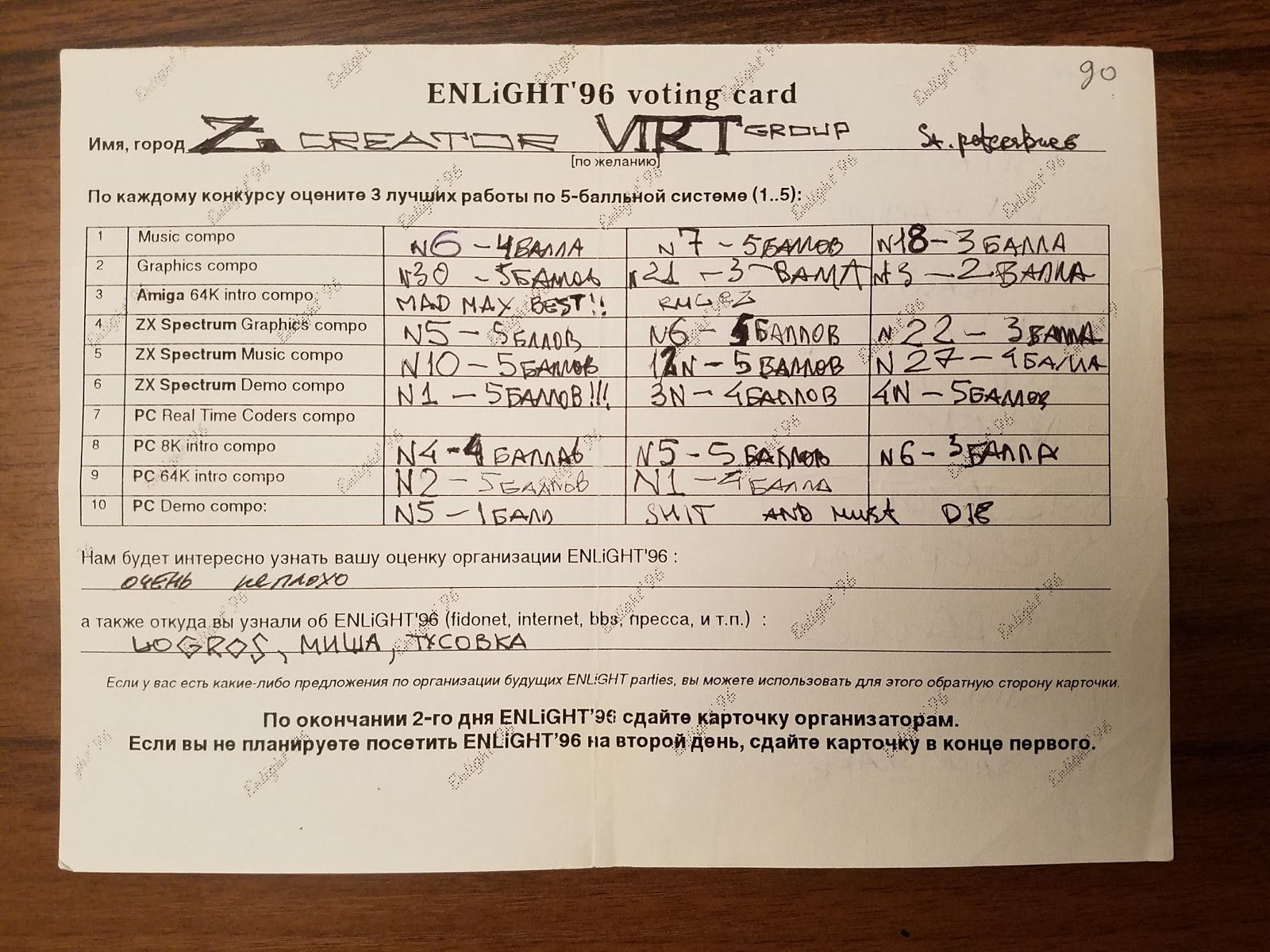
Voting questionnaire at ENLiGHT'96. From the personal archive of Peter Sobolev
ENLiGHT'97, last
In 1996, there were many works, everyone liked it, the next year we decided to repeat it again. In 1997, Voenmech hosted demopati - thanks to my boss (I entered graduate school there after LITMO) we were given an assembly hall. As in the first two festivals, there was registration of participants. There was a table, and everyone was filling out a questionnaire. All three years, everything was free. Thus, we avoided problems: they did not get to the bottom of us, and it is unlikely that many would pay for it. The queue for registration lined up almost to the Tekhnologicheskiy institut metro station. 1600 people came by questionnaires alone. And at all - only two volunteers, maintaining order.
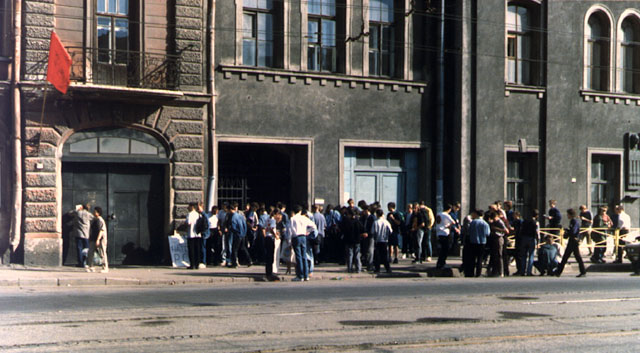
The same queue. Photo from the personal archive of Peter Sobolev
The assembly hall was large, but on the second floor. This has become a problem, because moving the resisting body from the first or second floor is a fundamental difference. In general, over the years of the demopath, we as organizers have learned a lot.
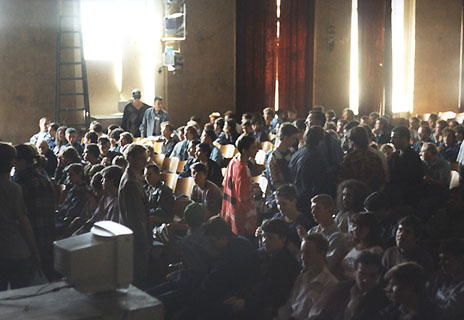
ENLiGHT'97, Voenmeh assembly hall
At first everything went well. We started showing our work on VGA monitors - the projector was still unavailable, and monitors were replacing TVs. Then the people were partially drunk, someone ran with an air rifle, someone painted the toilet. By the end of the day, it took on a bad character, and the university administration told us that this was unacceptable. We conferred and decided to close the festival. They hung up a piece of paper: "Sorry, the second day is canceled." The people came and began to row right at the entrance. The police arrived.
After that, we realized that we needed to change something. We tried to look for sponsors, but, unfortunately, at that time it was unrealistic. Those who were at the Invekom-98 exhibition at Lenexpo could see a strange banner - ENLiGHT'98. Someone was even surprised: they say, it seemed. No, it didn't seem. It was a rehearsal for a small number of people. But in the end, we didn't find sponsors, so ENLiGHT ended there.
Chaos Constructions
In 1999, completely different people, most of whom were not familiar with us, did almost the same thing on their own. However, on a smaller scale. In the school assembly hall (by a strange coincidence, a stone's throw from the school where we used to sit at the Commodore 64), they organized a Chaos Constructions'99 demopart. The same idea - contests: music, demos, graphics, about a hundred people to the people. Like ENLiGHT'95, only a projector appeared, and in general everything became more decent.
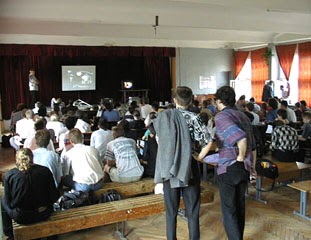
Chaos Constructions Festival, 1999
The audience liked it, and we were also interested. Then they did Chaos Constructions in 2000, 2002, 2003. The organizers were different, but mainly Vsevolod Potapov and his friends were engaged in this. I was on all SS, for two years they took place in the Voskhod cinema. And before 2004 we - the organizers of ENLIGHT and CC - agreed to try to hold the next festival together.
We conducted Chaos Constructions'2004 at LDM, and it was already a different level. A large room, a normal projector, the first exhibition of retro computers (which later became annual). We had to solve quite serious organizational issues, including those that were not visible to visitors. Roughly speaking, everyone grew up: someone as an organizer, someone as a programmer, someone as an administrator. None of us paid any of us, but people got a lot out of it. Someone, thanks to new acquaintances, found a job, someone improved their qualifications. From an organizational standpoint, the experience is absolutely invaluable. You manage 20-30 people who you don't pay and who don't have to obey you. Exclusively due to the authority and the fact that you express some sound thoughts.
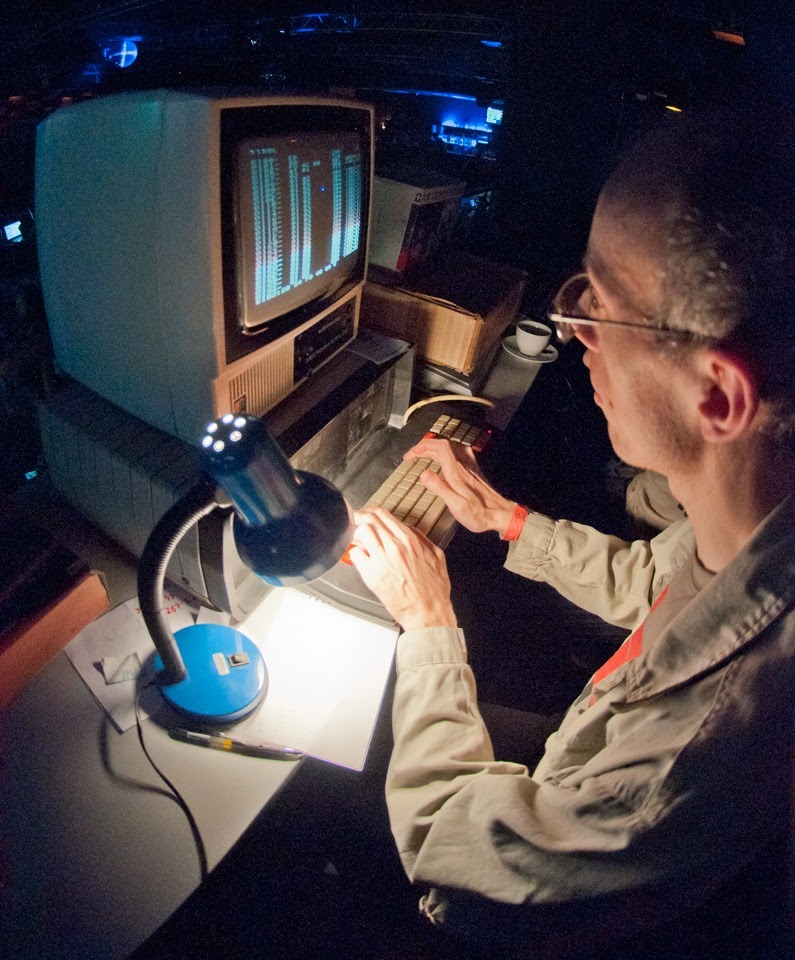
Pyotr Sobolev writes a program in machine codes for a personal computer "Agat", presented at the exhibition of retrocomputers - part of the Chaos Constructions'2012 festival.
I even wrote then a full-fledged project management system - just for CC. A friendly company created a 3D engine specially for us to show screensavers and schedules on the big screen.
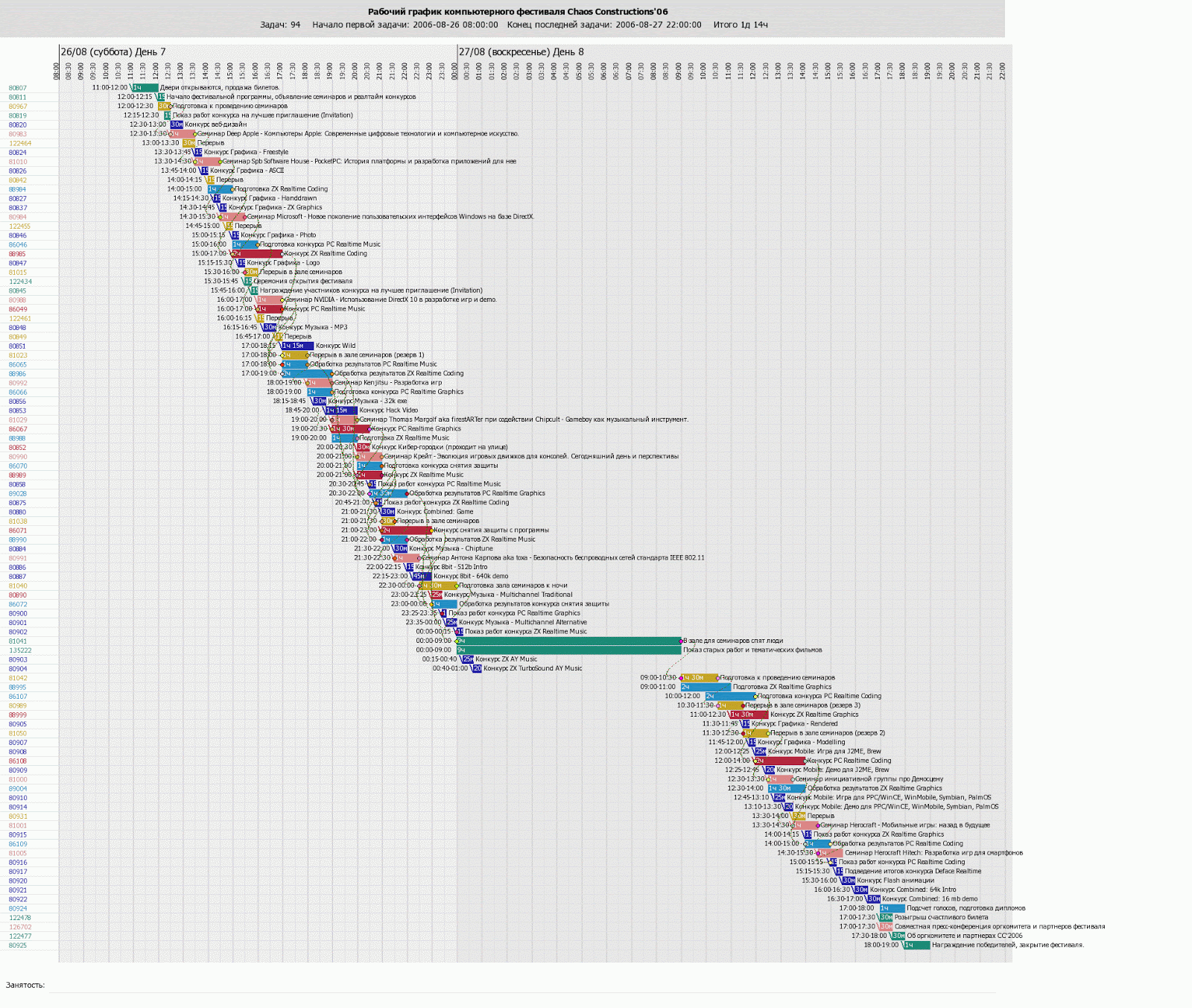
Screenshot of the project management system for the Chaos Constructions festival, written by Petr Sobolev
In 2005, the festival in the same place at LDM was similar in meaning to the previous one, but in 2006 it was already very different. We held it near the Lesnaya metro station, in the pavilion of the Eurasia exhibition center. The hall is large, and in order to raise the level and attract people, we decided to add more themes. Network security, games - everything, right down to blogs. We divided the premises into zones - for gamers, hackers, etc. Some areas later fell off, but others turned out to be interesting to many.
In particular, network security has attracted people's attention. The topic is semi-legal: on the one hand, there are people who break the law, on the other, those who ensure the protection of information. It is clear that this is always on the verge, a person can calmly do both. We somehow tried to stay on this brink, although it was not easy. One side was worried all the time that the organs would come and everyone would be arrested. Another said that we don't have hackers here, but a kindergarten. But due to the fact that our team had several authoritative people in this environment, we managed to ensure a fairly good level. As for the organs, we informally warned them through acquaintances in advance. They did not hide anything: we are holding such an event, we are not breaking the law. For all the years, there have never been any problems.

A large screen with Wi-Fi passwords flying over the air. Hackzona Chaos Constructions'2009
At competitions, people temporarily broke our internal network, which we specially organized, was engaged in social engineering. In particular, the task was to find out the serial number of the cartridge in the printer, which was in a certain theater. One of us worked there as the head of IT and provided all the conditions. The people began to call the theater, to speak teeth to the employees. It is clear that the boss did not warn anyone.
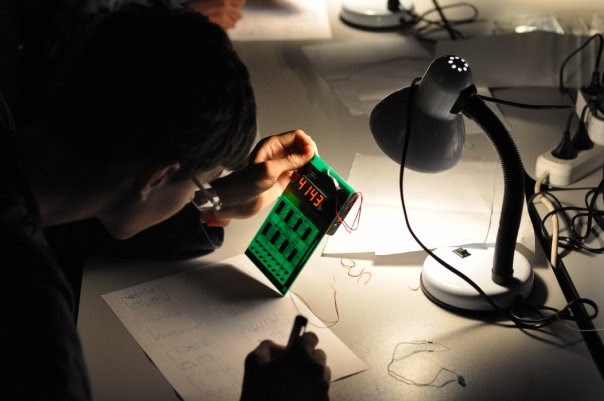
The task of one of the Chaos Constructions contests is to understand the scheme and "defuse the bomb" with a countdown
It is also important that CC'2006 was the first, where quite a lot of people came with their computers, like at the western demo party. Previously, this was impossible with us - no one really had laptops, and few people had personal cars to transport bulky desktop computers with monitors.
Chronicle from the Chaos Constructions'2006 festival
Demoscene now
From 1996 to 1999, in my opinion, there was a crisis. I'm not talking about Russia, but about the whole world. 3D accelerators appeared, and people, instead of thinking about the plot, rushed into all this: "Let's spin a bagel, spin 5 bagels, and if there are 100 bagels, it will be super!" The demos, which took first places at the world's largest parties, were made technically cool, but most of the time they were completely uninteresting to watch. This also affected the platforms from which the demoscene began. If the PC at least has 3D accelerators - that is, it was clear why they began to twist these bagels, then on the Commodore 64 and Amiga there were no accelerators, and for some reason many people there also wanted to twist the bagels. It looked sad. That is, when they try to twist something at 6502 1 MHz with a terribly slow video buffer, this is perhaps in itself worthy of respect, but the meaning is unclear.
Somewhere in the late 90s - early 2000s, people got tired of it, and again works with an interesting plot and design began to appear. People began to think about more than technology. Now everything is fine in principle, the demoscene exists and develops. Moreover, for old platforms they write no less than for modern ones. For convenience, they write on emulators, and demonstrate it on hardware - on old machines.
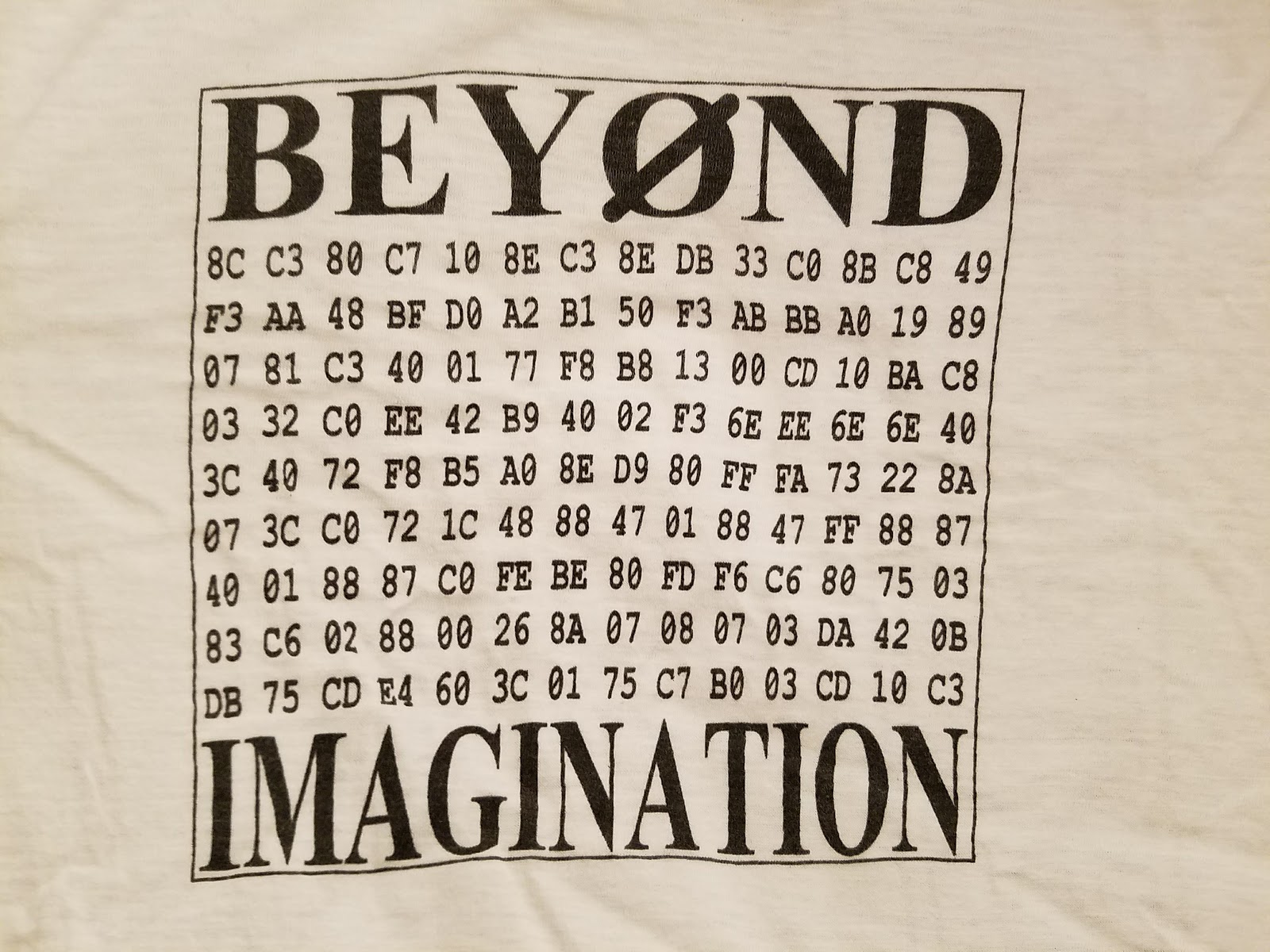
T-shirt for the ENLIGHT'96 festival with the Cross intro code printed on it (by MadMax), occupying only 128 bytes
It is impossible to commercialize the demoscene and, in my opinion, this is a plus. Even if you really want to make money, you still won't succeed. The very essence of the demo does not imply any useful use: you cannot sell or rent it. If you make it interactive, it will be a game, not a demo. The border is very clear. So the demoscene is still a bit underground and, if I may say so, pure creativity.
Incidentally, with the above-mentioned topic of network security, alas, the situation is different. I’m looking now where things have gone in it, and I’m sad. As soon as an opportunity arose, that is, a demand arose, people began to simply make money.
Teamwork
In my opinion, there are almost no iconic figures on the modern demoscene. This is not an area where the individual plays a major role, it is more teamwork. Therefore, it is the names of the teams that are more often known. Let's take one of the famous demos, for example, Second Reality 1993. Although it is already very old, written on a PC, its success is determined precisely by the combination of graphics, music and code. If you remove something, the demo will no longer be the same. This can be easily verified, for example, by simply turning off the sound.
The Finnish team Future Crew, which wrote this demo, was famous, I can't even name anyone comparable in popularity to them in those years. From the old teams, the same Fairlight is still good. They started on the Commodore 64, then Fairlight on the Commodore Amiga - partly with other people, then they switched to PC. But on all three platforms, Fairlight periodically releases some pretty decent stuff.
Art and code
Many people call the demoscene modern art, but it seems to me that they are divided by a line that runs along the line of code. If a person has made, for example, an animated video that even resembles a demo, he does not become a demo. People make animation for other purposes, and the essence of the demoscene involves writing code. The demo must work and do something in real time. Since now the limit for it is tens of megabytes, you can cram there animation of a fairly decent quality, but this will not be adequate. You will be ridiculed. Nobody is against some small animation inserts, but people understand that the essence is in the code, and in modern art the code has nothing to do with it. A completely different area.
What will happen next is a difficult question. In the mid-1990s or early 2000s, few could have foreseen that writing for the old platforms of the 1970s and 1980s would become popular, and that this popularity would only grow. It's strange: the hardware is getting better, opportunities are being added, but people are more interested in getting more from the old platforms, and on new platforms, the popularity of contests with strict size restrictions is growing. Now it seems obvious why this is so, but then it was not clear. So in the future it is completely unclear what to expect. It seems to me that the direction in which computers are now developing is not very demoscene. This applies, in particular, to avoiding binding software to specific platforms, emulating everything and everything, etc. With regard to the demoscene, I would rather believe that old platforms will be even more popular than they are now.
What will happen next in terms of technology - we do not know. For example, the jump associated with computers could not have been foreseen. Once upon a time, experts said that no one needed a computer, except for production and accounting, but it did not work out that way. What will happen next is a dark matter.